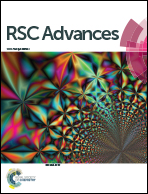The mechanism of different sensitivity of meso-substituted and unsubstituted cyanine dyes in rotation-restricted environments for biomedical imaging applications†
Abstract
A series of cyanine dyes have been excellent environment-sensitive fluorescent probes in live cells as well as in living tissue imaging due to their low quantum yields in solution but also their large fluorescence enhancements in microenvironments. In this paper, a new mechanism of different environmental sensitivity of meso-substituted and unsubstituted cyanine dyes in rotation-restricted environments (DNA or viscosity) for biomedical imaging applications is proposed on the basis of experimental observations and quantum-chemically calculated potential energy curves for twisting around the various C–C bonds in the polymethine chain. Computational studies on these dyes reveal substituents on the bridge decrease the energy barriers for rotations around different chemical bonds, which play a major role in reducing fluorescence quantum yield in a free state and providing a high environmental sensitivity for the meso-substituted cyanine dyes. The energy barriers and energy gaps to the rotations of C–C bonds strongly depend on the choice of substituents in the meso-position of the polymethine chain. The results might provide a foundation for the interpretation of the behavior of the dyes and are useful for the future design of new cyanine fluorophores.


 Please wait while we load your content...
Please wait while we load your content...